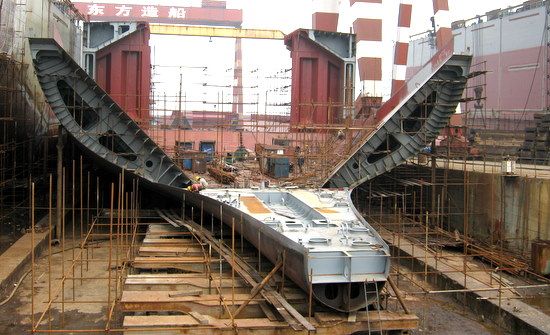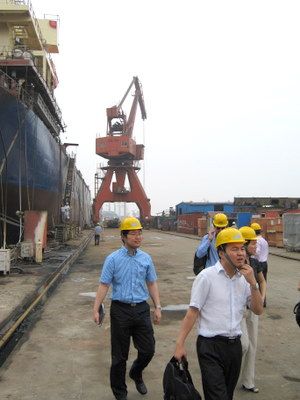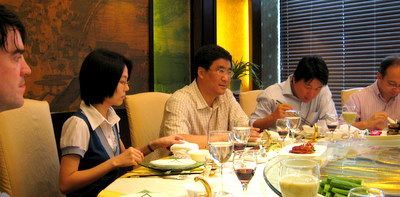

JES International Holdings Ltd, a Jiangsu province-based shipbuilding group, saw its bulk carrier operations steam ahead of its traditional core reliance on container vessels around two years ago.
And despite some rough sailing in both businesses due to the lingering global economic crisis, the Singapore-listed manufacturer has no regrets about the shift in emphasis to dry bulk vessels. Indeed, it expects a turnaround in cargo traffic – likely within a few months -- to precede an uptick in demand from products shipped globally by containers.
Speaking with visiting analysts and fund managers recently, Mr. Jin Xin, Chairman and CEO of JES, said that the primary products that his company’s vessels transport – commodities such as iron ore, coal, soybeans, cotton – typically benefit from an earlier rebound than their downstream cousin manufactured goods, as they are often the raw material inputs used in their production.
Some of these commodities including coal and soybeans also enjoy a certain degree of “recession-proof” immunity as they are considered staples of the energy and food sectors and often not discretionary.
“We began to see dry bulk carrier business as a better bet going forward in around 2006, but of course this does not mean that everything is not dependent on how the market in general goes,” he recently told NextInsight and accompanying industry analysts at the company’s shipyard.
The global economic downturn “continues to cast a shadow on the shipbuilding industry,” he said, especially as financing for new builds remain tight and shipowners are still cautious about making new orders.

Indeed, the first quarter showed some of the fallout from an anemic global economy.
Revenue for the January-March quarter increased 5.8% year-on-year to 215.5 mln yuan, as it increased its rate of production of vessels.
Bulk carriers contributed 96.1% of revenue for the first quarter compared to 73.1% a year earlier as the group continued its focus on building larger and higher valued bulk carriers.
In the first quarter, JES delivered one 53,800 deadweight tonne (DWT) bulk carrier and continues to build mainly the 37,500 DWT, 53,800 DWT and 79,800 DWT-class bulk carriers.
However, it recorded gross profit of 20.3 mln yuan, a decline of 56.4% from a year earlier. This was a result of higher costs of production, including higher costs of raw material which were purchased last year.
“The first quarter was not so impressive, But when the economy picks up again, we will overperform,” Mr. Jin said.
The company’s shift to bulk carriers was part of its overall growth strategy.
“Our bulk carriers overtook our container ships around the end of 2006/beginning of 2007,” he said, ”which coincides with some of the early signs of the impending economic housing crisis and credit crunch with some of the first upticks in savings and loans failures and a growing foreclosure rate in the North American real estate market.
Great profitability from the former was also a determining factor for JES’s strategic production shift.
“We saw at that time that although our main revenue still came from container ships, we realized better margins from bulk carriers and began to shift in this direction around three years ago,” Mr. Jin said.
Recovery less largo for cargo than containers
Mr. Jin is confident that the company’s gradual shift in emphasis over the past few years to dry bulk carriers will reap bigger and earlier dividends than if the shipbuilder were still primarily dependent on global container traffic and the vessels that carry them around the world.

“Of course bulk carrier operations is affected by the global slowdown, but not as severely as container ships. And we do expect selling prices (for bulk carriers) to improve this year,” Mr. Jin said.
He said shipbuilders did enjoy a certain level of immunity vis-à-vis other heavy industries as they had less inventory headaches to worry about given the nature of the business – ie: build to order production.
“We are purely demand driven, we build based on hard orders. In fact, most of our yards are full to around 2011-2012,” Mr. Jin said.
He was confident that the prices for the goods stored in the firm’s bulk carrier hulls will rebound soon, thus spurring orders from shippers for new vessels.
“Commodity prices will rise this year, and this will justify our shift to bulk carriers.”

JES operates shipyards strategically located in the Yangtze River Delta -- a short drive from China’s commercial capital Shanghai.
The company enjoys logistical support due to its being centered within a cluster of shipbuilding peers, yet is further downstream than most competitors, saving on transportation costs and affording it enhanced access to deepwater areas and more stable currents.
It is also closer to advanced transportation systems and a wide range of suppliers.
Now covering a gross land area of approximately 167,000 square meters, with the completion of a new yard by the end of this year, the total production space will skyrocket to 467,000 sq m.
Total riverfront access will increase to 1,000 meters from 720 currently, making launches and in-water operations far less crowded.
And for vessel launches themselves, JES has two slipways each able to accommodate a 100,000 deadweight ton (DWT) vessel.

The new facility will also sport a 130,000 sq m hull steel structure shop and auxiliary facilities. “The hull steel structure workshop allows indoor operations. Weather here can be quite nasty, especially during the rainy season,” Mr. Jin said.
Total costs of the new yard will run around 150 mln sgd, which the company will fund with proceeds from its Singapore listing in 2007.
“The new yard will provide us with significant additional construction capacity, allowing us to build simultaneously three bulk carriers of up to 176,000 DWT each; or 2 crude oil tankers of up to 300,000 DWT each; or very large ocean engineering vessels and offshore equipment such as oil rigs,” the company added.
Revenue from the new yard will start accruing from next year.







